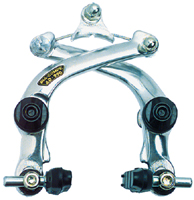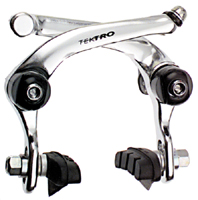Einstellen von U-Brakes: Unterschied zwischen den Versionen
(→Quelle: VGWort hinzu) |
(Übersetzungsanfang) |
||
| Zeile 1: | Zeile 1: | ||
U | [[U-Brake]]s sind [[Felgenbremse]]n deren Gelenke auf Rahmen oder Gabel montiert werden. Im Zusammenhang mit diesem Artikel solltest Du auch [[Das 1x1 der Felgenbremsen]] lesen. Dort werden unter anderem auch folgende Aspekte erläutert, die auf alle Arten von Felgenbremsen zutreffen: | ||
* Warum Felgenbremsen? | |||
* Typen von Felgenbremsen | |||
* Zentrieren | |||
* [[Hebelübersetzung]] | |||
* Geräusche/Quietschen | |||
* Typen von [[Bremsschuh]]en | |||
* Einstellen der Bremsschuhe | |||
Die meisten Probleme mit Felgenbremsen werden durch exzessive Reibung oder schlechte Montage der [[Züge]] verursacht. Schlechte Einstellung oder Bremsen geringer Qualität sind zumeist keine Gründe. | |||
;Siehe auch | |||
* [[Züge]] - über dir richtige Montage von Zügen und Bremshebeln. | |||
{{#widget:AdSense}} | {{#widget:AdSense}} | ||
Version vom 10. Juli 2018, 08:43 Uhr
U-Brakes sind Felgenbremsen deren Gelenke auf Rahmen oder Gabel montiert werden. Im Zusammenhang mit diesem Artikel solltest Du auch Das 1x1 der Felgenbremsen lesen. Dort werden unter anderem auch folgende Aspekte erläutert, die auf alle Arten von Felgenbremsen zutreffen:
- Warum Felgenbremsen?
- Typen von Felgenbremsen
- Zentrieren
- Hebelübersetzung
- Geräusche/Quietschen
- Typen von Bremsschuhen
- Einstellen der Bremsschuhe
Die meisten Probleme mit Felgenbremsen werden durch exzessive Reibung oder schlechte Montage der Züge verursacht. Schlechte Einstellung oder Bremsen geringer Qualität sind zumeist keine Gründe.
- Siehe auch
- Züge - über dir richtige Montage von Zügen und Bremshebeln.
Was ist eine U-Brake?
A U brake is a brake that works like a centerpull caliper, only with the pivots mounted directly to the frame or fork. The "L"-shaped arms cross over above the tire, so the left brake shoe is operated by the right side of the transverse cable. A U brake uses studs (bosses) attached to the front fork or frame above the rim, rather than below it, as with conventional cantilevers. U brakes use the same type and placement of studs as rolle-rcam brakes do.
In 1986-88 there was a fad for equipping mountain bikes with U brakes mounted underneath the chainstays. This provided a nice clean look to the seatstay area of the bicycle, and provided a somewhat simpler cable routing. In addition, as the chainstays are larger and more rigid than typical seatstays, the "problem" of flexing of the studs under load was reduced. Conventional cantilever brakes cannot be mounted on the chainstays, because they would get in the way of the cranks.
Although U brakes were cool-looking and powerful, the fad died quite abruptly when people actually started using the bikes that were sold with chainstay-mounted U brakes. They had several serious drawbacks:
- The inaccessible location made it very difficult to service or adjust the brakes.
- They complicated the process of wheel removal.
- They tended to get clogged with mud.
- The mechanical advantage would decrease as the brake was applied harder, and as the brake shoes wore.
- Due to the high-mounted studs, if you didn't monitor the brake shoe wear carefully, as they would wear, they would hit higher and higher on the rim. Eventually, they would overshoot the rim and start rubbing on the tire sidewall.
In recent years U brakes have been making a bit of a comeback on freestyle bikes.
Einstellen von U-Brakes
First, remove the arms from the studs, and make sure the studs are free of rust. Coat the studs liberally with grease (this is VERY important!)
Install the arms with them at their maximum spread and tighten the bolts that hold them to the frame. This is how you set the springs. Only connect the transverse cable after this has been done.
A U brake uses a conventional brake lever, not the special lever with longer cable pull used with direct-pull brakes (V brakes). Set the transverse cable as short as possible for best braking, and adjust the cable and lever. (See the article about cables). There is usually a small setscrew on the side of one of the arms for fine adjustment of spring balance. Adjust the brake shoes. (See information on brake shoes in the lead article on rim brakes.)
Check the brake shoe adjustment frequently due to the decrease in mechanical advantage as the brake shoes wear, and their migrating higher and higher up on the rims. If you don't keep on top of the adjustment, they will eventually start rubbing on the tire sidewall. Many thousands of tires have been ruined by this.
Siehe auch
Quelle
Dieser Artikel basiert auf dem Artikel Adjusting "U-Brake" Bicycle Brakes von der Website Sheldon Browns. Originalautor des Artikels ist Sheldon Brown.
- Sattelstützenmaße
- Knarzen, Knacken und Quietschen
- Ritzelabstände (Tabelle)
- Auswechselbarkeit von Vierkant-Kurbelaufnahmesystemen bei Innenlagern
- Kettenlinienstandards (Tabelle)
- Ein bequemer Sattel
- Nabenbreiten (Tabelle)
- Alles über Nabenschaltungen
- Shimano Nexus und Alfine Acht-Gang-Naben
- Reifengrößen

